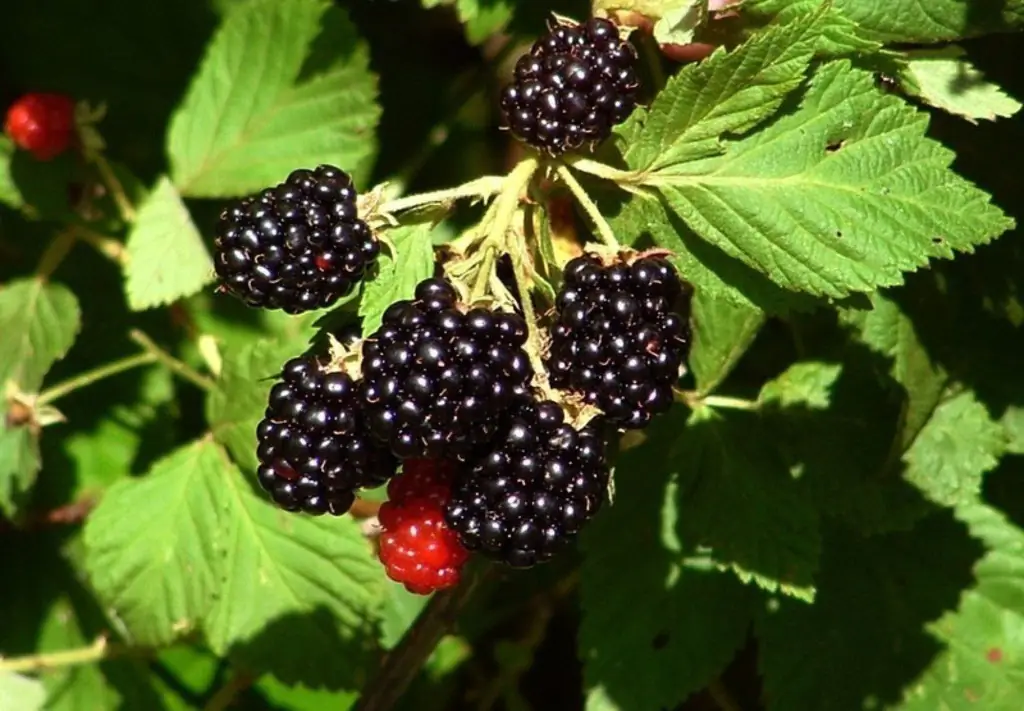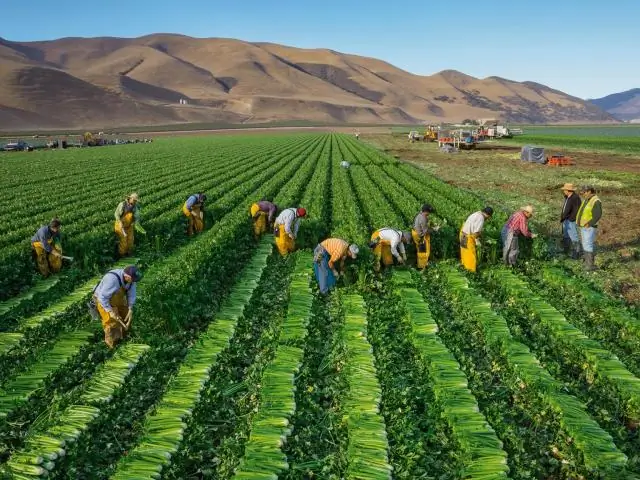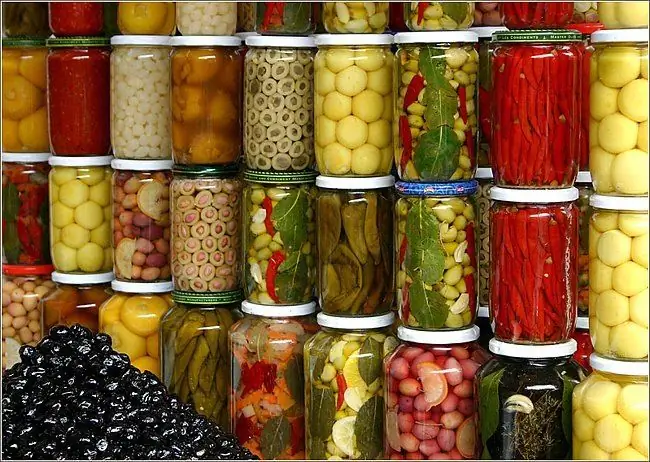
Table of contents:
- Author Bailey Albertson [email protected].
- Public 2024-01-17 22:26.
- Last modified 2025-06-01 07:32.
Cucumbers Siberian garland F1 - a new super-yielding variety

Every year, vegetable growers face a difficult task, to choose among the cucumber novelties of breeding achievements those varieties that will delight with taste and give a bountiful harvest. Not so long ago, cucumbers appeared, capable of laying ovaries in bunches or bouquets. One such plant bears several times more fruit than ordinary varieties. Cucumbers Siberian garland F1 from this series.
Content
-
1 Siberian garland F1 - variety description
- 1.1 Cucumber Siberian garland - video
- 1.2 Advantages and disadvantages of the variety - table
-
2 Planting cucumbers varieties Siberian garland F1
- 2.1 Site selection and soil preparation
- 2.2 Video: an unusual garden for cucumbers
- 2.3 Growing and planting cucumber seedlings
- 2.4 Planting seedlings in a greenhouse - video
- 2.5 Planting cucumbers of the Siberian garland variety with seeds in the garden
-
3 Care for cucumbers varieties Siberian garland F1
- 3.1 Watering
- 3.2 Top dressing
- 3.3 The regularity and composition of dressings for cucumbers of the Siberian garland variety - table
- 3.4 Formation of plants of the variety Siberian garland and a garter on trellises
- 3.5 Correct shaping - video
-
4 Diseases and pests of cucumbers Siberian garland F1
- 4.1 Pests of cucumbers varieties Siberian garland F1 - table
- 4.2 Cucumber pests - photo gallery
- 5 Harvesting and storage
- 6 Reviews of vegetable growers
Siberian garland F1 - variety description
Cucumber variety Siberian garland F1 refers to a new type of cucumber with a bunch or bouquet of ovaries. Created at the Chelyabinsk breeding station in 2012. Very early - the first fruits are removed 45 days after germination, super-yielding. One plant can grow up to 400 gherkins or 40 kg of fruit per square meter of area.
The hybrid is parthenocarpic, the fruits are formed without pollination. Tied in any weather. It can grow both in a greenhouse and in an open garden. The Siberian garland has a powerful bush, the creators of the hybrid do not advise planting more than two plants per square meter of area. To reveal all the advantages of the variety, correct formation and timely feeding are required. Affects the yield and the timeliness of removing ripening fruits. Subject to the rules, it can bear fruit for several months, until autumn frosts.
Cucumber Siberian garland - video
Fruits are dark green, 5-8 cm long, with light tips. Pubescent with light soft spines. Delicious, sweet and aromatic. They are good both fresh in salads and in various preparations. There is no genetically bitterness in cucumbers, no voids are formed during salting. They do not outgrow, allowing summer residents to collect greens no more than 1 time a week. The hybrid is hardy. Resistant to cold snaps and droughts. Does not reduce fruiting in cool weather, does not become infected with powdery mildew, brown spot. The variety is not afraid of the tobacco mosaic virus and peronosporiosis.

The ovaries of the Siberian garland are arranged in bunches of 5-8 pieces in one knot
Advantages and disadvantages of the variety - table
| Benefits | disadvantages |
| Yield | Demanding to the correct formation and care of plants. |
| Long-term fruiting | The high cost of hybrids. |
| Disease resistance | The need to buy seeds annually, since those harvested from grown fruits do not repeat the maternal characteristics. |
| Great fruit taste | |
| Ability not to outgrow for several days | |
| Tolerance to growing conditions: bears fruit equally both indoors and outdoors | |
| Self-pollination | |
| Tolerance to growing conditions: bears fruit equally both indoors and outdoors | |
| The ability to get a large harvest from a small area |
Planting cucumbers varieties Siberian garland F1
Site selection and soil preparation
The place for cucumbers is chosen sunny, but with light partial shade. They grow well at a soil temperature of not lower than 15 of C. Therefore, regardless of the selection method for cultivation in the open or closed ground under cucumbers equipped warm beds. A trench is dug in the direction from south to north, 70-80 cm wide, arbitrary length, 30-40 cm deep. Fill it with removed turf, roots up, hay or cut grass, chopped branches. Compacted, covered with excavated soil mixed with humus or compost, add 1 glass of deciduous tree ash per 1 m 2and watered abundantly. The prepared bed is covered with foil. In a few days, the process of decomposition of plant residues will begin, with the release of heat, and the soil will begin to warm up from below. When the soil temperature reaches 15-16 o C at a depth of 5 cm, you can plant seeds or seedlings in the garden bed.
Video: unusual cucumber garden
Growing and planting cucumber seedlings
As a rule, hybrid seeds of the Siberian garland are sold already processed and do not need to be disinfected and heated. The soil for seedlings is bought or prepared by themselves in the proportion: 1 part of the land from the garden bed (steamed), 1 part of compost or humus, 1 part of peat, only neutral, not acidic, 1 part of rotted sawdust. The soil should be loose and water-absorbing.
Seedlings are sown for seedlings in mid-April in the middle lane, that is, 30 days before planting in a greenhouse or garden bed. Pots for seedlings are best made of paper. Black and white newspapers are suitable in several layers, from which bags are formed and filled with soil mixture. Place two seeds in one container on the edge, sprinkle with soil on top so that the seeds are buried 2 cm. Water carefully. The strongest is chosen from the sprouted sprouts, and the second is carefully cut off with scissors. Caring for plants consists of watering regularly and providing the necessary light so that the plants do not stretch out. There is no need to feed the seedlings, especially with nitrogen fertilizers, everything you need is already laid in the soil.

Newspaper pots allow you to preserve the root system of seedlings during transplanting
Thirty day old seedlings are planted in a greenhouse. To do this, make holes in the garden at a distance of 50 cm, according to the size of the pots, water well and set the seedlings without removing them from the bags. The newspaper will quickly soften in wet soil, and the roots of the seedlings will develop beyond it. The seedling method allows you to get the first ripe cucumbers already at the beginning of June, two to three weeks earlier than those planted with seeds.
Planting seedlings in a greenhouse - video
Planting cucumbers of the Siberian garland with seeds in a garden
Hybrids, which include the Siberian garland cucumber, are good because they can grow both in protected and in open ground. Cucumber seeds are planted in the garden at the end of May, when the nights become warmer and the threat of late frosts has passed. In the prepared bed, holes are made at a distance of 40-50 cm from each other. It is not recommended to plant cucumbers of this type closer. Since cucumbers are very thermophilic plants, it will be useful to cover the beds from above with arcs and cover them with agrospan or film for the night. On warm days, shelters can be removed during the day.

Cucumber bed, equipped with arches for shelter in the night cold
Care for cucumbers varieties Siberian garland F1
Caring for plants consists in carrying out certain actions:
- watering and mulching the soil,
- dressing,
- the formation of plants and a garter on trellises.
Watering
Even a short lack of moisture in the soil negatively affects the condition of the cucumbers. Therefore, they need to be watered regularly, avoiding drying out. On dry and hot days - every day. Better in the morning, at the root, abundantly, 3-5 liters per plant. Water for irrigation should be warm, settled, without chlorine and other impurities. Cucumbers grow well when equipped with drip irrigation. Sprinkling with these plants is contraindicated. To retain moisture, the soil under the cucumber bushes is mulched with dried chopped grass with a layer of at least 7-10 cm.

Drip irrigation helps to bring moisture directly to the plant roots
Top dressing
Siberian Garland F1 cucumbers require frequent feeding to ensure a bountiful harvest. The composition of fertilizers is very different. You can do without the use of chemistry, folk remedies, which is no less effective. It is best to fertilize the cucumbers every week, changing the composition of the dressings. The procedure is carried out after abundant watering so as not to damage the delicate roots.
The regularity and composition of dressings for cucumbers varieties Siberian garland - table
| Period | Top dressing composition |
| 1 time after germination, when the bushes reach 10-15 cm | Infusion of onion peels: pour a quarter of a bucket of peels with 10 liters of boiling water, insist and water the plants for a day at the rate of 1 glass of infusion per bush. |
| 1 time per month (alternating feeding weekly) | Green fertilizer: fermented herbal infusion. Half a bucket of chopped grass (nettle, clover, calendula, etc.) is poured with a bucket of water, a handful of humus or compost is added and infused for 2 weeks. Take 1 liter of infusion in a bucket of water and water the cucumber bushes under the root. |
| Bread leaven: fill a bucket 2/3 with bread crusts (only without mold!), Pour warm water and leave for a week to ferment. Dilute the sourdough 1/3 and water the cucumbers with 0.5 cans per bush. | |
| With diluted milk: milk and water 1/2. Water the plants: 1 glass under the bush. | |
| Weekly after first fruit set | Ash from deciduous trees. They bring 0.5 cups under the bush. |

Green fertilizer and ash are the best feeding for cucumbers
Formation of plants of the variety Siberian garland and garter on trellises
The Siberian garland F1 has increased requirements for the formation of a bush. If the plant is allowed to build a bush without external adjustment, its super-yielding properties will not appear, the fruits will be tied, like in ordinary varieties of cucumbers. It is necessary to form a plant into one stem. The lower nodes, up to the fourth inclusive, are blinded, that is, all the ovaries and stepsons are plucked out of the leaf sinuses. Then all the stepsons are removed above so that there is one shoot with leaves and bouquets of cucumbers in each node. All ripening fruits must be picked on time so that the development of the next batch does not slow down. You can give the bush freedom to form only after it reaches 2m. The lash is wrapped around the trellis and is no longer pinched.
Correct shaping - video
Diseases and pests of cucumbers Siberian garland F1
With proper care, cucumbers of the Siberian garland variety practically do not get sick. And pests, although they are not particularly scary to strong plants, can still infect individual plants.
Pests of cucumbers varieties Siberian garland F1 - table
| Pest | Damage | Control and prevention measures |
| Aphid | It settles in colonies on the stems and backs of young leaves and sucks the juices from the plant, weakening it. | Spraying or rinsing infected shoots in Fitoverma solution (according to the instructions for the preparation), with the addition of 1 tbsp. l. 10 liters of liquid soap water 2 times within 10 days. |
| Fly miner | Lays eggs in the thick cucumber leaf. The resulting larvae gnaw out the leaf from the inside, forming light stripes of a bizarre shape on it, thereby disrupting the plant's photosynthesis. |
|
| Thrips | Very small insects, invisible to the naked eye, suck the juices from the plant, spread viral diseases. |
|
| Spider mite | It populates and braids the back of the cucumber leaf with cobwebs, sucks the juices from the plant. | Treatment of plants with Acarin, Sunmite or Oberon acaricides, which are low-toxic to humans. |
Cucumber pests - photo gallery
-

Miners - Miner fly larvae gnaw tunnels in a cucumber leaf, drawing bizarre patterns
-

Miner fly - Minerfly lays eggs in the leaf
-

Spider mite - A spider mite in dry and hot weather is able to destroy all plants in the greenhouse in a short time
-

Spider mite - The top of the shoot, entwined with a web, stops growth and gradually dies
-

Spider mite - Spider mites live on the back of the leaf and gradually cobweb the entire plant
-

Thrips enlarged - Enlarged Thrips
-

Thrips colony - Thrips are tenacious and fertile
-

Thrips - Thrips is dangerous because its presence is not immediately noticeable, and the damage is tangible
-

Cucumber aphid - A colony of aphids on the back of a cucumber leaf can deprive the grower of half of the crop
-

Miner - Traces of a miner fly larva on a cucumber leaf
Harvesting and storage
Cucumbers are harvested as soon as they reach the required size, for the Siberian garland it is 5-8 cm. In the midst of fruiting, you can collect greens every day. This is especially true of bunch cucumbers, which include the Siberian garland. Ripe cucumbers left on the bushes do not overripe, but do not allow the next ovaries to form in their place. With proper collection, up to 40 kg of gherkins can be harvested from one bush.
Despite the thin skin, the transportability of the Siberian garland cucumbers is high. They can be stored in the refrigerator for 5-7 days. If each cucumber is wrapped in a napkin and folded in a perforated bag, it can be kept fresh for up to 3 weeks.
Cucumbers of the Siberian Garland variety are good fresh, but it is best to harvest them for the winter. They are salted, fermented, pickled, canned in various ways.

Cucumbers Siberian garland are delicious in any form
Reviews of vegetable growers
Siberian garland F1 - new generation cucumbers. According to gardeners, only a few bushes of this wonderful vegetable can feed a family of several people all summer. Everyone speaks of the variety with enthusiasm, mentioning the excellent taste and absence of diseases, noting that in order to achieve such high results, it is imperative to observe the growing conditions: the correct formation of the plant and the feeding regime. The variety has many more advantages than disadvantages.
Recommended:
Care And Cultivation Of Blackberries In The Country: From Seeds, From Cutting, Video And Photo

Tips and practical advice for growing blackberries from seeds and cuttings. Soil preparation, watering, fertilization, care during the growth period
Cucumber Variety Ekol F1 - Description, Care And Other Features + Video

Cucumber variety Ekol F1 - a description of the features of care, cultivation, collection and storage of the crop
How To Transfer Plastic Windows To Winter Mode And Vice Versa: Do-it-yourself Adjustment Features, Video And Photo

How to correctly transfer a plastic window to winter and summer mode. Features of the fittings responsible for such a function
How To Grow Cabbage Seedlings At Home In Different Ways: When To Sow, Features Of Care With Video, Lunar Calendar

How to grow cabbage seedlings at home: rules for preparing seed and soil, especially sowing and care
What Can Be Prepared For The Winter: Recipes For Preparations From Mushrooms, Cabbage, Tomatoes, Cucumbers And Other Vegetables + Video

Recipes for preparations for the winter from mushrooms, cucumbers, tomatoes, bell peppers. Salads, cuts, marinades, essential foods, useful tips
